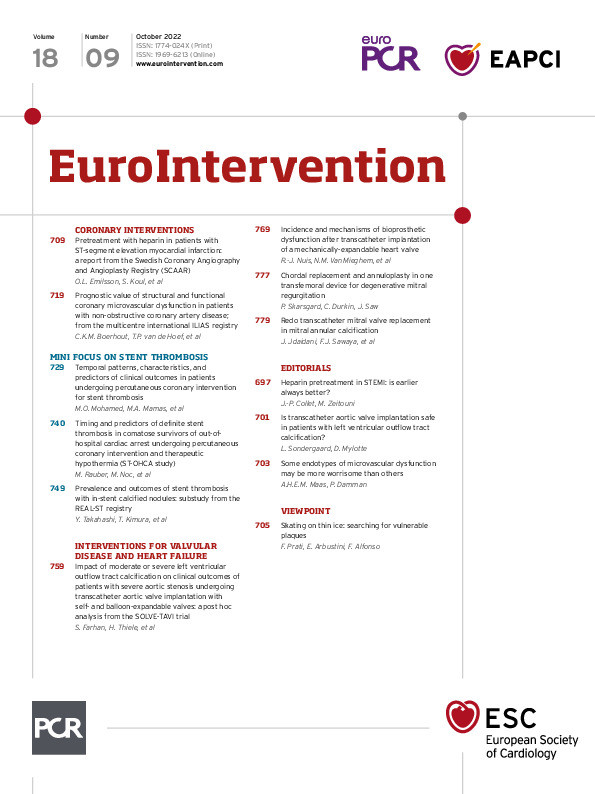A large proportion of patients (up to 70%) undergoing coronary angiography because of angina and/or evidence of myocardial ischaemia do not have obstructive coronary arteries (ANOCA)1. Coronary vasomotor dysfunction is highly prevalent in ANOCA, especially in female patients2. Coronary vasomotor dysfunction can be divided into epicardial and/or microvascular vasospastic disease and coronary microvascular dysfunction (CMD). Current guidelines stress the importance of performing invasive spasm provocation testing and guidewire-based assessment of microvascular dysfunction by coronary flow reserve (CFR) and/or microcirculatory resistance (MR) measurements in these patients34.
The diagnosis of CMD is important for optimal treatment decisions regarding symptoms and prognosis. The CorMicA Trial has shown that stratified pharmacotherapy based on the results of invasive coronary function testing improves anginal complaints5. Since then, we have learnt that distinct endotypes exist within CMD: the structural endotype and the functional endotype6. Whether these different endotypes require different treatment for angina or have a different prognosis is currently unknown.
In this issue of EuroIntervention, Boerhout et al have published an important paper on the prognostic value of differentiating between structural and functional CMD in ANOCA. The Inclusive Invasive Physiological Assessment in Angina Syndromes (ILIAS) Registry collaboration provides valuable information on this subject7. In this registry, 1,102 patients with stable angina and non-obstructive coronary artery disease, excluded by intracoronary physiology, underwent CMD assessment by Doppler-based or thermodilution-based intracoronary techniques. Functional CMD was defined by an abnormal CFR in combination with normal MR and structural CMD by an abnormal CFR with abnormal MR. While an abnormal CFR was associated with an increased risk for major adverse cardiac events (MACE) and target vessel failure (TVF) at 5-year follow-up, solely abnormal microvascular resistance parameters were not. The risk for MACE and TVF at 5-year follow-up was similarly increased for patients with structural or functional CMD compared with patients with normal microvascular function.
While the paper highlights the importance of CMD assessment for prognosis, a couple of important comments should be made. First, the prevalence of CMD in the current cohort is high, suggesting that the patients undergoing these flow and resistance measurements were selected. Second, the majority of patients were male. We emphasise that there is a strong female preponderance for coronary vasomotor dysfunction in ANOCA, with relevant underlying sex differences in pathophysiology8. Therefore, these results will need replication in a female cohort. Third, there is a large overlap between vasospastic disease and microvascular dysfunction and this has not been taken into account2. Finally, the novel and valuable continuous thermodilution method to assess microvascular dysfunction should be included in future studies4.
With regard to treatment for prognosis, the structural CMD group is characterised by the presence of a more traditional cardiovascular risk profile and might theoretically benefit from lifestyle advice and preventive medication. In contrast, the functional CMD group is characterised by an impaired autoregulation or a higher resting myocardial oxygen demand at rest69. Currently, there are no proven therapeutic options for these mechanisms.
For complaints, there are no data available on the differential effect of the various CMD endotypes on anginal symptoms. We note that while an elevated MR with normal CFR was not shown to be of prognostic importance, this may possibly identify patients with complaints based on hypertension.
We conclude that the current registry demonstrates again the importance of accurate CMD assessment for prognosis. Therefore, adequately powered and performed clinical trials for the treatment of angina and clinical outcomes should be undertaken, taking the different endotypes into account and with an even distribution of male and female patients.
Conflict of interest statement
P. Damman received research grants and consultancy fees from Philips, and research grants from Abbott. A. Maas has no conflicts of interest to declare.
Supplementary data
To read the full content of this article, please download the PDF.

